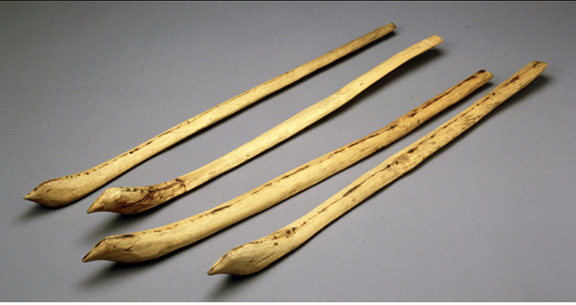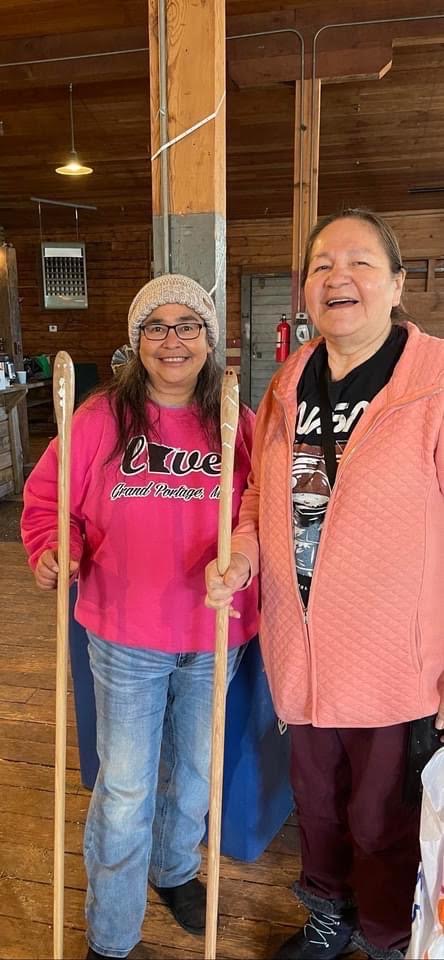
By Dan Ninham
Although there were still patches of snow in northern Minnesota in late April the snowsnake season is over. However, the prime time to make snowsnakes may be at this time during the maple sugar season when the trees are green and have sap in them.
The nonprofit Manidoo Ogitigaan, directed by Zac Earley (White Earth Ojibwe) and Kaitlyn Grenier of Bemidji, MN, organized a snowsnake building gathering in Bemidji in late February that brought together various levels of snowsnake interests. Manidoo Ogitigaan, translated to be the Spirit Garden, is one of the leaders in Ojibwe language and cultural revitalization with grassroots community efforts that are expanding their reach (https://www.manidooogitigaan.org).
“I am interested in snowsnakes as a part of our Anishinaabe culture,” Earley said. “I am new to snowsnakes although I have heard of it before. Madeline Island was the first time playing. We look to our culture and way of life to bring about positive change.”

Snowsnake is a medicine game
“Snowsnake is a medicine game for healing so we sought out knowledgeable people to share their knowledge with us and the community. Our goal is to help strengthen our communities by supporting culture and language,” said Earley.
“Snowsnake historically was played by many tribes each with unique stories and teachings about snowsnake. In our Ojibwe belief the ginebig, translated as “snake” in Ojibwemowin, is a guardian of medicine and is a healer. So I’ve had a special interest in the game before I’ve ever played,” Earley added.
The snowsnake game has evolved in north central Minnesota Ojibwe country. Not only in appearance but also in how it is played. The type of snowsnake that was built at Bemidji workshop had an eastern influence with pouring a melted metallic substance in the snowsnake head. This is consistent with Iroquoian-type snowsnakes. Some surfaces have used the ridge with a path cut through it while others have shoveled a wide path on the ice and even others threw on the frozen top crust.
Looking at the archives of the Minnesota Historical Society, there are images of snowsnakes from over a hundred years ago. Nowadays there are several different types and lengths of snowsnakes in Minnesota, including painted branches, long and short slender pieces of wood with or without lead in the end or on the head, and flattened pieces of wood without lead often cut from a school’s wood shop.
Historians have published images and writings about Ojibwe snowsnakes as early as 1860 by J.G. Kohl in “Kitchi-Gami: Wanderings round Lake Superior.” Others have claimed the beginning of snowsnakes started 400 to 600 years ago but indigenous people don’t put a date on the origin.

Everyone made their own snowsnake
Earley said the snowsnake workshop was very important because it allowed people the opportunity to work with tools and each other to learn about making their own snowsnake. First language Ojibwe and Cree speaking Anishinaabekwe elder Mary Moose shared language and a story about the snowsnake. Earley is in the process of transcribing and translating her story.
Moose brought her snowsnake that appeared to about five feet long and had metallic substances on the bottom of the head. She said it was over 150 years old and was her great grandfathers. Moose’s home territory is at Fort Albany First Nation in eastern Ontario near the western border of Quebec. This is directly north of Iroquois country and may have been an influence in having lead in the snowsnake head.
Kevin Finney was one of the leaders in the snowsnake building workshop. He is the director of his own nonprofit based in Hopkins, MI called the Great Lakes Lifeways Institute. His longtime woodworking and craftsman friend was Frank Sprague, Gun Lake tribal member, who both have made several trips not only to the Red Lake Nation but throughout the country sharing their trades.
“My first experience with snowsnakes was when we took some community members from Ponemah to Madeline Island,” Grenier said. “We loved it, and wanted to have a snowsnake game and workshop closer to home, especially after Bob Shimek, a Red Lake band member, shared the Ojibwe legend of snowsnakes with us. Bob has been working with Ojibwe snowsnakes for 30 years.”

Way more than a workshop
Veronica Smith (Fond du Lac Ojibwe) became interested in snowsnake games when she saw it played in other communities. She and Mary Moose attended the workshop. “I began asking members in my community if this would be something they would be interested in doing in our own community.”
“The workshop started in a good way, we smudged every day and throughout the day songs were sung while other organizers prepared a meals,” said Smith. “We all worked on our snakes at our own pace, Kevin and Frank were always there to answer questions and provide assistance.”
Smith said about the snowsnake building workshop: “The three days went by quickly. It felt good to be in company of knowledgeable and respected relatives from Indian country. The teachings, food, teasing and laughter is what I’ve missed the last couple of years. I am hoping to bring a workshop like this to Nagaajiwanaang (Fond du Lac Band of Lake Superior Ojibwe) next winter. These types of winter activities are healthy mentally and physically.”
Thomas Howes (Eagle Clan from the Fond du Lac Ojibwe) lives in Duluth. He talked about the snowsnake workshop that was held at the Rail River site in Bemidji, “I’ve known Kevin (Finney) for a few years, admired his craftsmanship and that drew me to participate in the workshop. I’ve assisted Bob Shimek with snowsnake events in Fond du Lac over the past decade by preparing the course with my staff at Fond du Lac Natural Resources Program. I’ve also played the games he’s held over here with my family.”
“The workshop was well organized and executed, but it was way more than a workshop, it was a gathering of passionate and talented people. The workshop was an opportunity to tell stories, sing, trade, and network on many levels, something that has been limited in the past couple years,” added Howes.






